Changes of Microstructures and Mechanical Properties in Commercially Pure Titanium after Different Cycles of Proposed Multi-Directional Forging
Abstract
1. Introduction
2. Materials and Methods
2.1. Sample Preparation
2.2. The Proposed Multi-Directional Forging
2.3. Microstructural Characterization
2.4. Mechanical Characterization
3. Results
3.1. Morphology Evolution of Deformed Specimens
3.2. Optical
3.3. TEM
3.4. Hardness
3.5. Tensile Tests
4. Discussion
4.1. Effect of Microstructural Evolution on the Mechanical Properties
4.2. Effect of Microstructural Evolution on the Tensile Facture Toughnesss
5. Conclusions
- With the increase of MDF cycles, grains were finer and more homogeneous, with less in the way of defects. Initial polygonal grains had disappeared, and the GBs became ambiguous.
- By TEM, grain size and dislocation density decreased with increasing the cycles of MDF. The mean grain size was about 1 μm, 500 nm and 200 nm respectively after one, two and three cycles of MDF. In all MDF specimens, there was high dislocation density, but twins were not directly found. Therefore, within this study, dynamic recrystallization was the dominant grain refinement mechanism of MDF CP Ti.
- For fractographs, there were numerous dimples and tear ridges in UFG CP Ti. By increasing the cycles of MDF, this increased the number of dimples, but then the dimple size decreased to the scale equal to, or even less than, the grain size, and cleavage features also appeared gradually. In other words, the fracture mode of UFG CP Ti was mixed.
Author Contributions
Funding
Acknowledgments
Conflicts of Interest
References
- Kim, H.; Lim, S.; Yeo, I.; Kim, W. Stress-induced martensitic transformation of metastable β-titanium alloy. Mater. Sci. Eng. A 2007, 450, 322–325. [Google Scholar] [CrossRef]
- Li, C.; Chen, J.; Li, W.; He, J.J.; Qiu, W.; Ren, Y.J.; Chen, J.L.; Chen, J.H. Study on the relationship between microstructure and mechanical property in a metastable β titanium alloy. J. Alloys Compd. 2015, 627, 222–230. [Google Scholar] [CrossRef]
- Jiang, Z.; Wang, P.; Li, D.; Li, Y. The evolutions of microstructure and mechanical properties of 2.25Cr-1Mo-0.25V steel with different initial microstructures during tempering. Mater. Sci. Eng. A Struct. Mater. 2017, 699, 165–175. [Google Scholar] [CrossRef]
- Mikhaylovskaya, A.; Kotov, A.; Kishchik, M.; Prosviryakov, A.; Portnoy, V. The effect of isothermal Multi-Directional forging on the grain structure, superplasticity, and mechanical properties of the conventional Al–Mg-Based alloy. Metals 2019, 9, 33. [Google Scholar] [CrossRef]
- Cai, C.; LingHui, S.; XingHao, D.; BaoLin, W. Enhanced mechanical property of AZ31B magnesium alloy processed by multi-directional forging method. Mater. Charact. 2017, 131, 72–77. [Google Scholar] [CrossRef]
- Jiang, M.G.; Yan, H.; Chen, R.S. Microstructure, texture and mechanical properties in an as-cast AZ61 Mg alloy during multi-directional impact forging and subsequent heat treatment. Mater. Des. 2015, 87, 891–900. [Google Scholar] [CrossRef]
- Wang, B.; Liu, C.; Gao, Y.; Jiang, S.; Chen, Z.; Luo, Z. Microstructure evolution and mechanical properties of Mg-Gd-Y-Ag-Zr alloy fabricated by multidirectional forging and ageing treatment. Mater. Sci. Eng. A 2017, 702, 22–28. [Google Scholar] [CrossRef]
- Vasilev, E.; Linderov, M.; Nugmanov, D.; Sitdikov, O.; Markushev, M.; Vinogradov, A. Fatigue Performance of Mg-Zn-Zr Alloy Processed by Hot Severe Plastic Deformation. Metals 2015, 5, 2316–2327. [Google Scholar] [CrossRef]
- Khani Moghanaki, S.; Kazeminezhad, M.; Logé, R. Mechanical behavior and texture development of over-aged and solution treated Al-Cu-Mg alloy during multi-directional forging. Mater. Charact. 2018, 135, 221–227. [Google Scholar] [CrossRef]
- Li, K.; Injeti, V.S.Y.; Trivedi, P.; Murr, L.E.; Misra, R.D.K. Nanoscale deformation of multiaxially forged ultrafine-grained Mg-2Zn-2Gd alloy with high strength-high ductility combination and comparison with the coarse-grained counterpart. J. Mater. Sci. Technol. 2018, 34, 311–316. [Google Scholar] [CrossRef]
- Boyer, R.; Welsch, G.; Collings, E. Materials Properties Handbook: Titanium Alloys; ASM International: Materials Park, OH, USA, 1998. [Google Scholar]
- Wang, B.; Wang, X.; Li, J. Formation and Microstructure of Ultrafine-Grained Titanium Processed by Multi-Directional Forging. J. Mater. Eng. Perform. 2016, 25, 2521–2527. [Google Scholar] [CrossRef]
- Xu, C.; Zhu, W. Comparison of microstructures and mechanical properties between forging and rolling processes for commercially pure titanium. Trans. Nonferrous Met. Soc. 2012, 22, 1939–1946. [Google Scholar] [CrossRef]
- Mironov, S.Y.; Salishchev, G.A.; Myshlyaev, M.M.; Pippan, R. Evolution of misorientation distribution during warm ‘abc’ forging of commercial-purity titanium. Mater. Sci. Eng. A 2006, 418, 257–267. [Google Scholar] [CrossRef]
- Zhang, D.; Li, S. Orientation dependencies of mechanical response, microstructure and texture evolution in hot compression of AZ31 magnesium alloy processed by equal channel angular extrusion. Mater. Sci. Eng. A 2011, 528, 4982–4987. [Google Scholar] [CrossRef]
- Ghosh, S.; Singh, A.K.; Mula, S. Effect of critical temperatures on microstructures and mechanical properties of Nb–Ti stabilized IF steel processed by multiaxial forging. Mater. Des. 2016, 100, 47–57. [Google Scholar] [CrossRef]
- Xia, X.; Chen, M.; Lu, Y.; Fan, F.; Zhu, C.; Huang, J.; Deng, T.; Zhu, S. Microstructure and mechanical properties of isothermal multi-axial forging formed AZ61 Mg alloy. Trans. Nonferrous Met. Soc. 2013, 23, 3186–3192. [Google Scholar] [CrossRef]
- Podolskiy, A.V.; Ng, H.P.; Psaruk, I.A.; Tabachnikova, E.D.; Lapovok, R. Cryogenic equal channel angular pressing of commercially pure titanium: Microstructure and properties. J. Mater. Sci. 2014, 49, 6803–6812. [Google Scholar] [CrossRef]
- Belyakov, A.; Tsuzaki, K.; Miura, H.; Sakai, T. Effect of initial microstructures on grain refinement in a stainless steel by large strain deformation. Acta Mater. 2003, 51, 847–861. [Google Scholar] [CrossRef]
- Hughes, D.A.; Chrzan, D.C.; Liu, Q.; Hansen, N. Scaling of misorientation angle distributions. Phys. Rev. Lett. 1998, 21, 4664–4667. [Google Scholar] [CrossRef]
- Zecevic, M.; Lebensohn, R.A.; McCabe, R.J.; Knezevic, M. Modeling of intragranular misorientation and grain fragmentation in polycrystalline materials using the viscoplastic self-consistent formulation. Int. J. Plast. 2018, 109, 193–211. [Google Scholar] [CrossRef]
- Chen, Q.; Lin, S.; Yang, C.; Fan, C.; Ge, H. Grain fragmentation in ultrasonic-assisted TIG weld of pure aluminum. Ultrason. Sonochem. 2017, 39, 403–413. [Google Scholar] [CrossRef] [PubMed]
- Suwas, S.; Beausir, B.; Tóth, L.S.; Fundenberger, J.J.; Gottstein, G. Texture evolution in commercially pure titanium after warm equal channel angular extrusion. Acta Mater. 2011, 59, 1121–1133. [Google Scholar] [CrossRef]
- Meredith, C.S.; Khan, A.S. The microstructural evolution and thermo-mechanical behavior of UFG Ti processed via equal channel angular pressing. J. Mater. Process. Technol. 2015, 219, 257–270. [Google Scholar] [CrossRef]
- Hajizadeh, K.; Eghbali, B. Effect of two-step severe plastic deformation on the microstructure and mechanical properties of commercial purity titanium. Met. Mater. Int. 2014, 20, 343–350. [Google Scholar] [CrossRef]
- Sanosh, K.P.; Balakrishnan, A.; Francis, L.; Kim, T.N. Vickers and Knoop Micro-hardness Behavior of Coarse-and Ultrafine-grained Titanium. J. Mater. Sci. Technol. 2010, 26, 904–907. [Google Scholar] [CrossRef]
- Karimi, M.; Toroghinejad, M.R.; Dutkiewicz, J. Nanostructure formation during accumulative roll bonding of commercial purity titanium. Mater. Charact. 2016, 122, 98–103. [Google Scholar] [CrossRef]
- Semenova, I.P.; Valiev, R.Z.; Yakushina, E.B.; Salimgareeva, G.H.; Lowe, T.C. Strength and fatigue properties enhancement in ultrafine-grained Ti produced by severe plastic deformation. J. Mater. Sci. 2008, 43, 7354–7359. [Google Scholar] [CrossRef]
- Lefebvre, S.; Devincre, B.; Hoc, T. Simulation of the Hall–Petch effect in ultra-fine grained copper. Mater. Sci. Eng. A 2005, 400–401, 150–153. [Google Scholar] [CrossRef]
- Sanders, P.G.; Youngdahl, C.J.; Weertman, J.R. The strength of nanocrystalline metals with and without flaws. Mater. Sci. Eng. A 1997, 234, 77–82. [Google Scholar] [CrossRef]
- Huang, T.; Shuai, L.; Wakeel, A.; Wu, G.; Hansen, N.; Huang, X. Strengthening mechanisms and Hall-Petch stress of ultrafine grained Al-0.3%Cu. Acta Mater. 2018, 156, 369–378. [Google Scholar] [CrossRef]
- Dudova, N.; Belyakov, A.; Sakai, T.; Kaibyshev, R. Dynamic recrystallization mechanisms operating in a Nie grained Al-0.3%Cr alloy under hot-to-warm working. Acta Mater. 2010, 58, 3624–3632. [Google Scholar] [CrossRef]
- Dutler, N.; Nejati, M.; Valley, B.; Amann, F.; Molinari, G. On the link between fracture toughness, tensile strength, and fracture process zone in anisotropic rocks. Eng. Fract. Mech. 2018, 201, 56–79. [Google Scholar] [CrossRef]
- Sun, X.; Guo, Y.; Wei, Q.; Li, Y.; Zhang, S. A comparative study on the microstructure and mechanical behavior of titanium: Ultrafine grain vs. coarse grain. Mater. Sci. Eng. A 2016, 669, 226–245. [Google Scholar] [CrossRef]
- Sun, Z.; Yang, H. Microstructure and mechanical properties of TA15 titanium alloy under multi-step local loading forming. Mater. Sci. Eng. A 2009, 523, 184–192. [Google Scholar] [CrossRef]
- Padap, A.K.; Chaudhari, G.P.; Nath, S.K.; Pancholi, V. Ultrafine-grained steel fabricated using warm multiaxial forging: Microstructure and mechanical properties. Mater. Sci. Eng. A 2009, 527, 110–117. [Google Scholar] [CrossRef]
- Ko, Y.G.; Shin, D.H.; Park, K.; Lee, C.S. An analysis of the strain hardening behavior of ultra-fine grain pure titanium. Scr. Mater. 2006, 54, 1785–1789. [Google Scholar] [CrossRef]


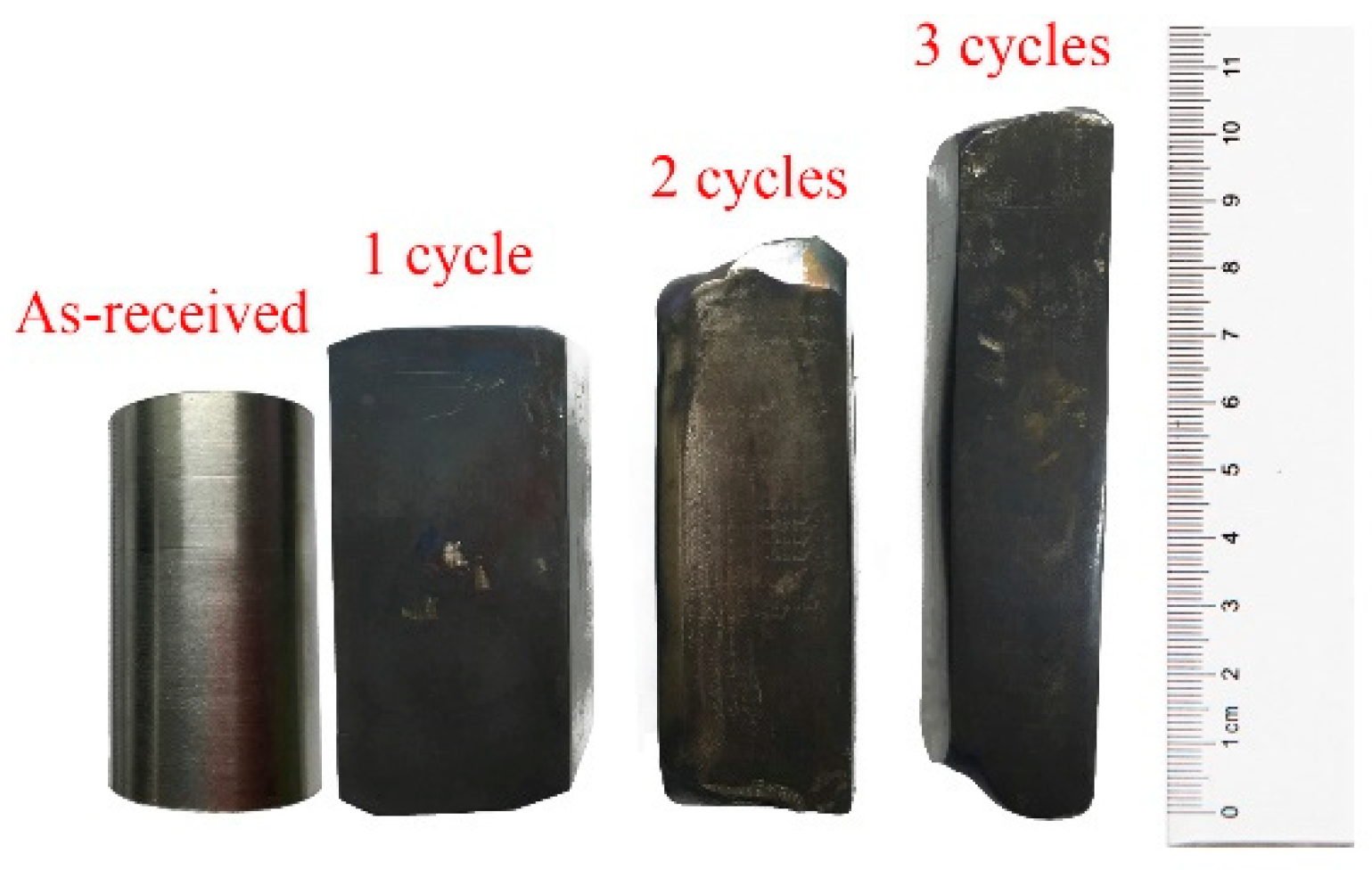

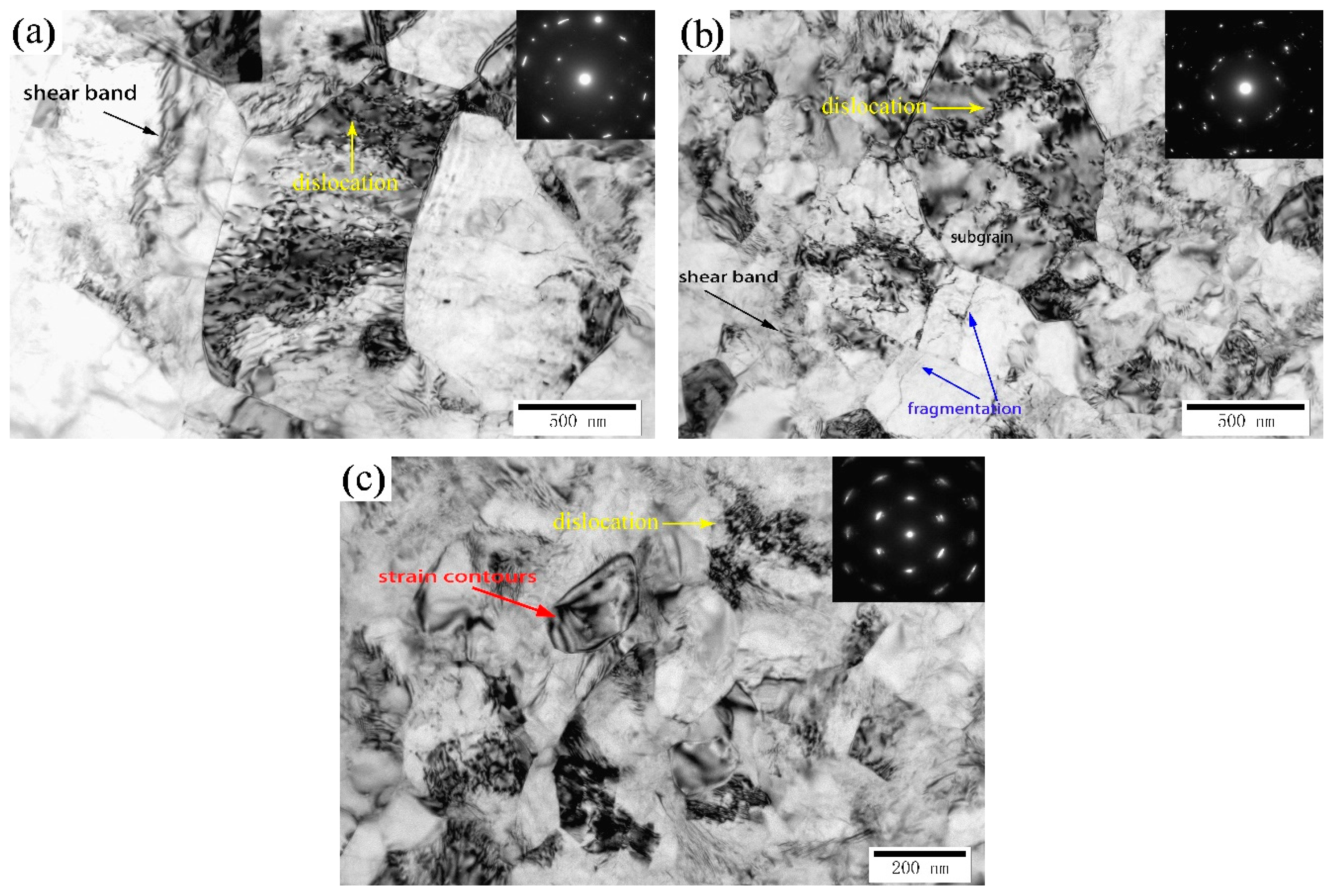
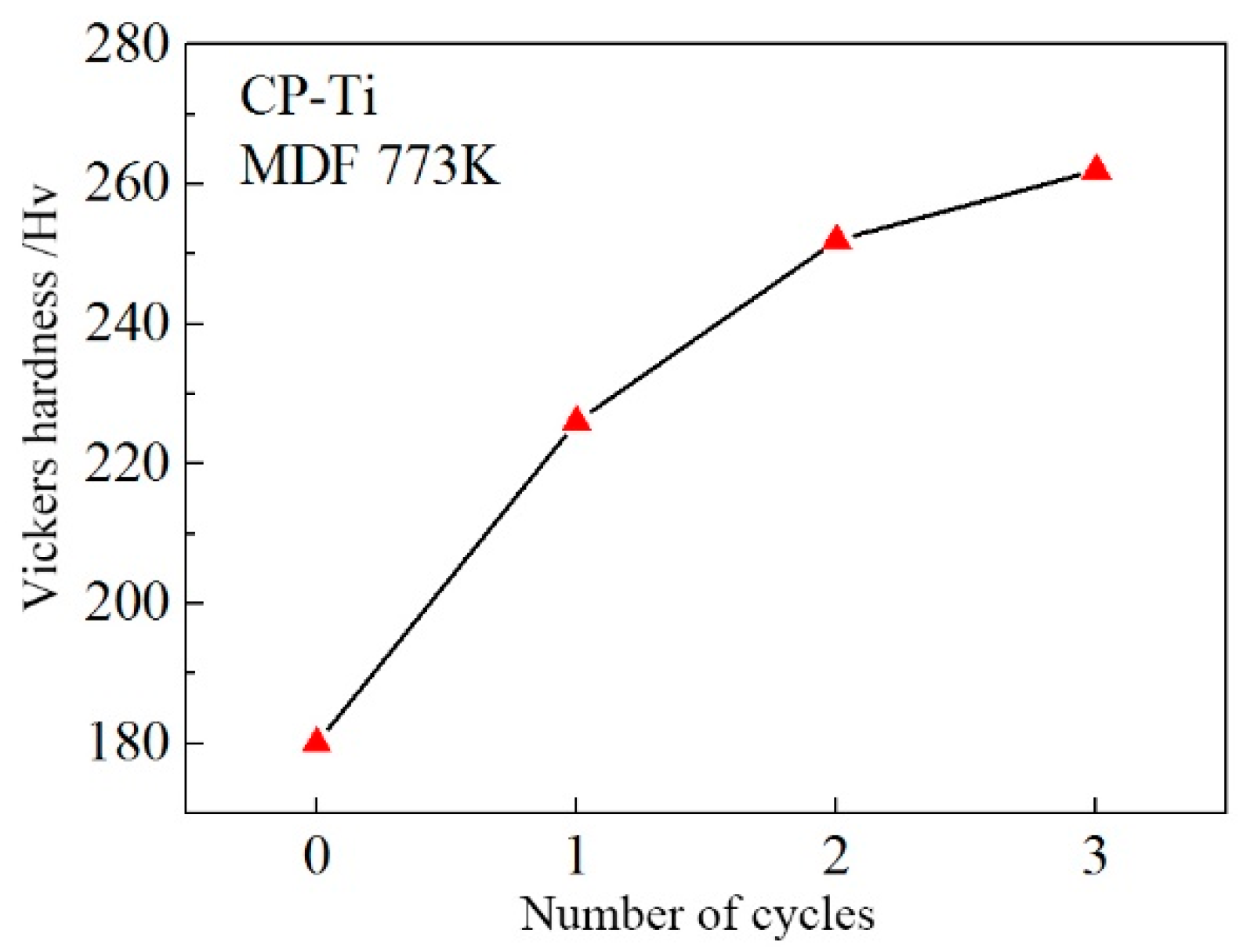
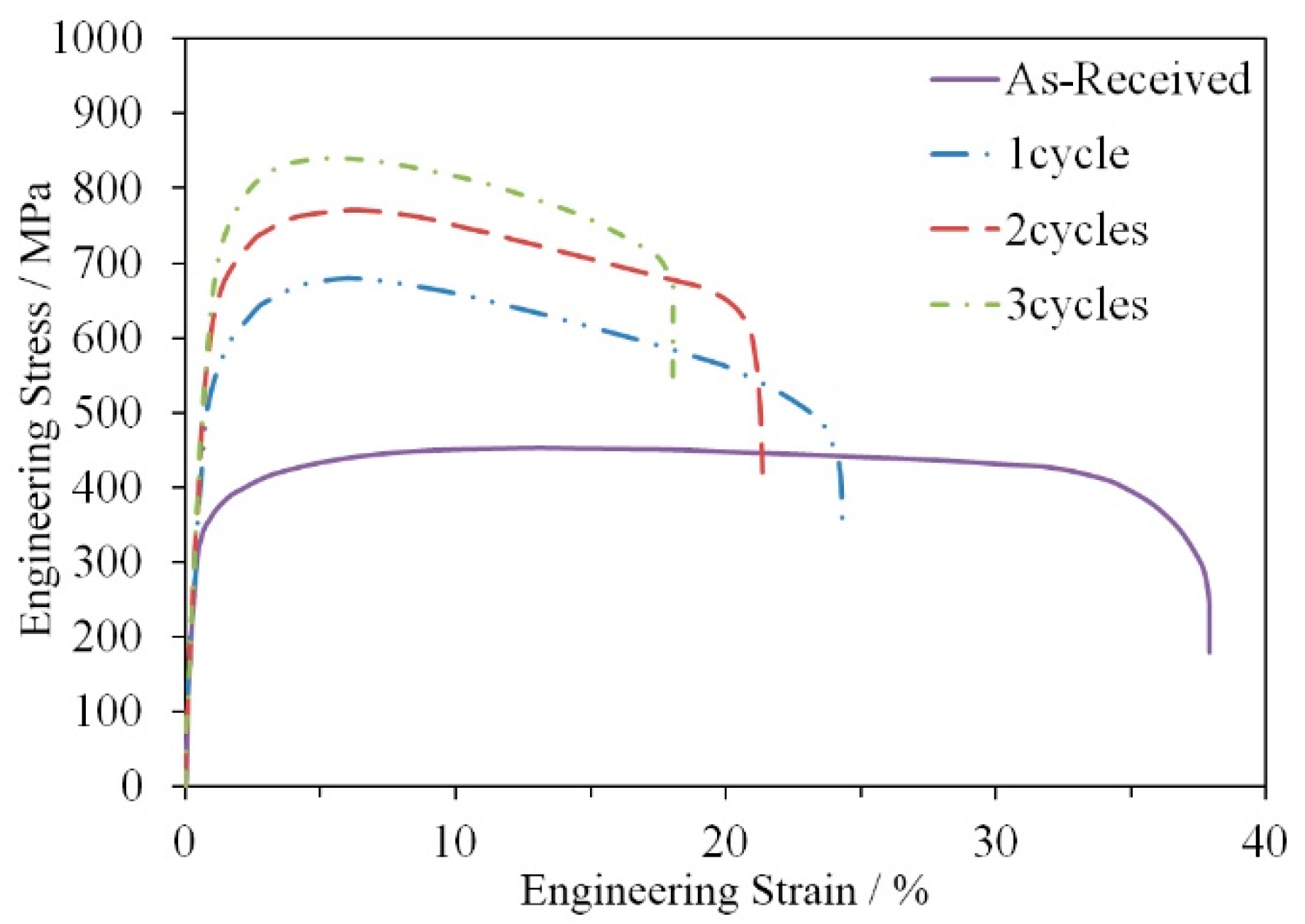

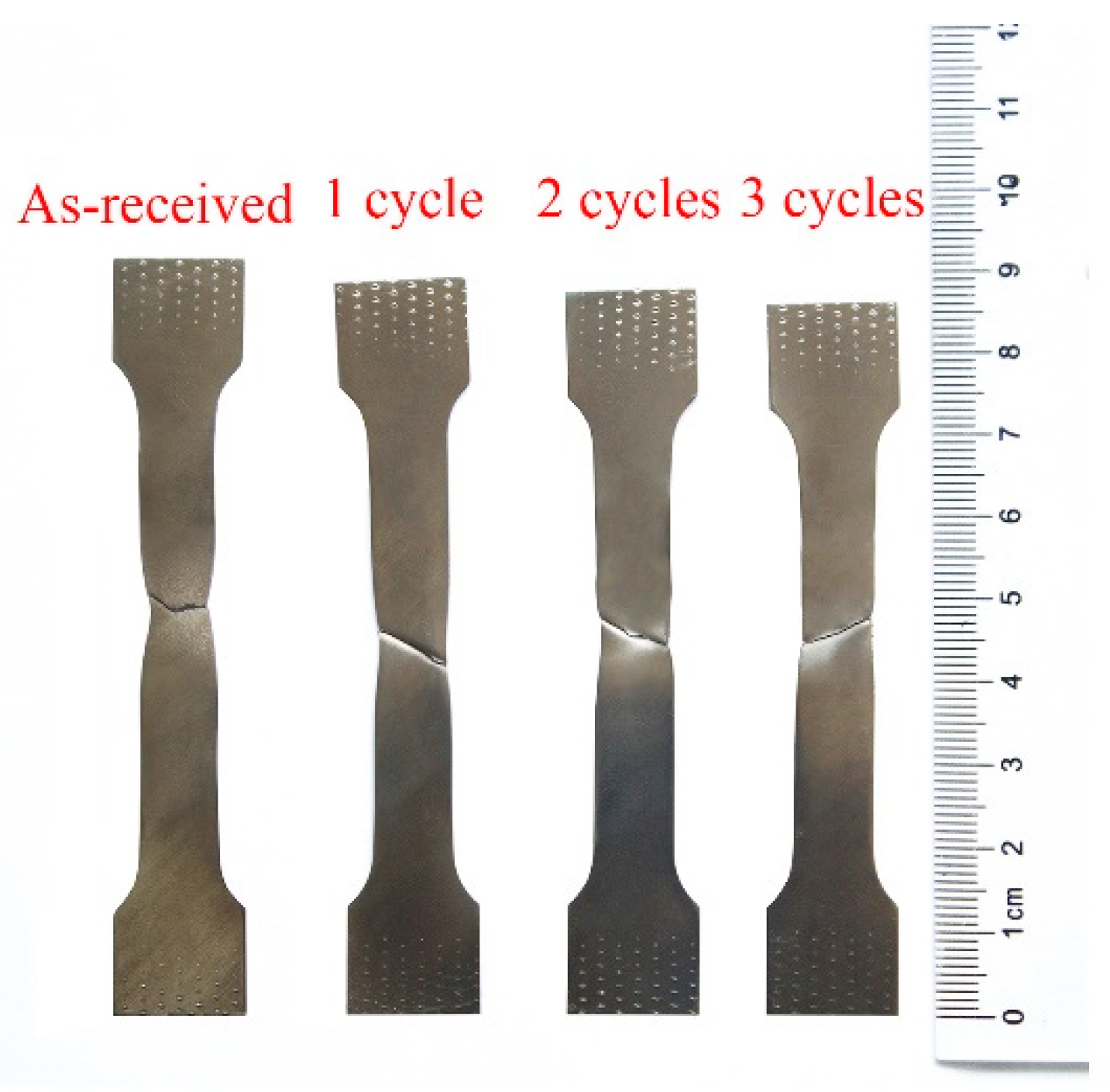
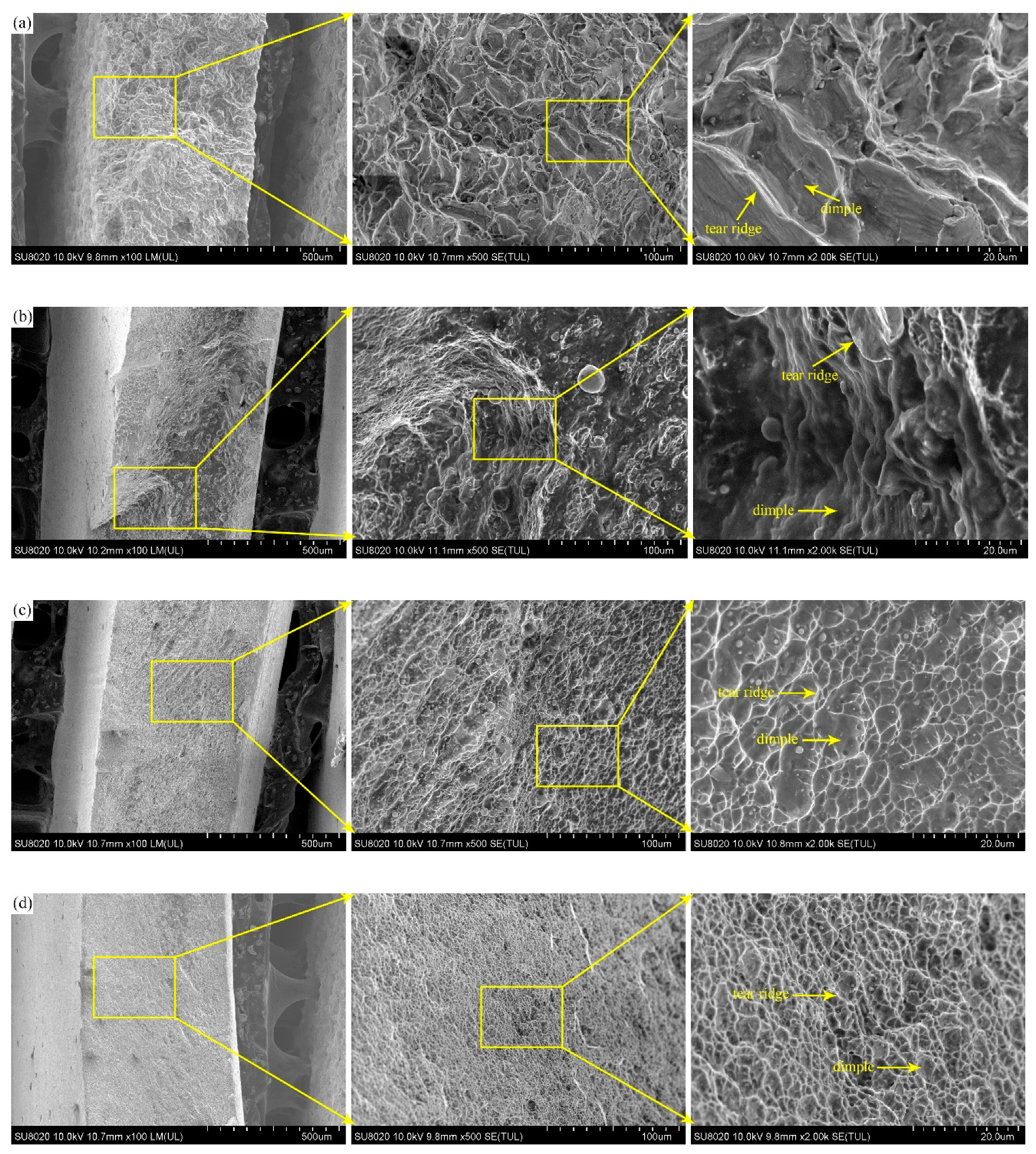
© 2019 by the authors. Licensee MDPI, Basel, Switzerland. This article is an open access article distributed under the terms and conditions of the Creative Commons Attribution (CC BY) license (http://creativecommons.org/licenses/by/4.0/).
Share and Cite
Zheng, Z.; Zhang, X.; Xie, L.; Huang, L.; Sun, T. Changes of Microstructures and Mechanical Properties in Commercially Pure Titanium after Different Cycles of Proposed Multi-Directional Forging. Metals 2019, 9, 175. https://doi.org/10.3390/met9020175
Zheng Z, Zhang X, Xie L, Huang L, Sun T. Changes of Microstructures and Mechanical Properties in Commercially Pure Titanium after Different Cycles of Proposed Multi-Directional Forging. Metals. 2019; 9(2):175. https://doi.org/10.3390/met9020175
Chicago/Turabian StyleZheng, Zhanguang, Xiaoying Zhang, Liang Xie, Longgui Huang, and Teng Sun. 2019. "Changes of Microstructures and Mechanical Properties in Commercially Pure Titanium after Different Cycles of Proposed Multi-Directional Forging" Metals 9, no. 2: 175. https://doi.org/10.3390/met9020175
APA StyleZheng, Z., Zhang, X., Xie, L., Huang, L., & Sun, T. (2019). Changes of Microstructures and Mechanical Properties in Commercially Pure Titanium after Different Cycles of Proposed Multi-Directional Forging. Metals, 9(2), 175. https://doi.org/10.3390/met9020175




